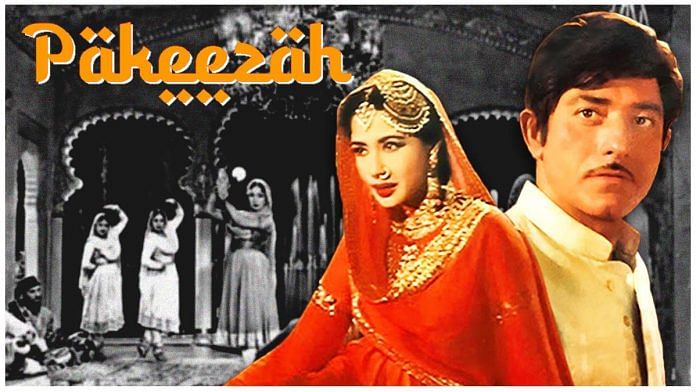There are some actors whose name instantly brings to mind just one film, and it’s the same film for pretty much everyone. And here, this is not because the actor’s repertoire was limited, but simply because that one film is so iconic, and so deeply embedded in public consciousness, that it has become inseparable from the actor’s identity. And for Meena Kumari, that film is, undoubtedly, Pakeezah.
When the movie released on 4 February 1972, it was not an immediate success. That is understandable, because Pakeezah was not originally intended for the 1970s audience, which had grown accustomed to the frothy romances of the ’60s and was getting ready to welcome kitschy masala films and the Angry Young Man trope. Pakeezah had been in the making since the mid-1950s — a slower, more graceful time.
But while the plot, of a courtesan and her forbidden love, may be anachronistic now, the movie’s central theme, of love and a desire to be accepted for who one is, stands every test of time and place. It also helps that Pakeezah is beautifully made, with gorgeous costumes (Meena Kumari herself was responsible for them), some lovely sets and achingly gorgeous music.
Also read: Mirza Ghalib: The movie was the perfect marriage of the poet’s words with Suraiya’s voice
So much more than its plot
The movie begins with Nargis (Meena Kumari), a courtesan who lives in a kotha run by her sister Nawabjaan (Veena Sapru), having run away with her lover, Shahabuddin (Ashok Kumar). But his father, Hakim Saab (D.K. Sapru) won’t hear of their respectable family’s name being sullied by the entry of a tawaif, and even as he berates his son and insults Nargis, she runs away and takes refuge in a graveyard. Shahabuddin searches high and low but never finds her, while she lives out the rest of her limited days in the cemetery, where she gives birth to their daughter.
She dies soon after, but not before she has written a letter to Shahabuddin. But that letter reaches him 17 years later, by which time Nawabjaan has come and taken the baby with her.
Years later, Nargis’ daughter, Sahibjaan (also played by Meena Kumari), is the cynosure of all eyes at the kotha as she performs Inhi Logon Ne Le Liya Dupatta Mera, courtesans swirling around in mujras in the background. Shahabuddin attempts to come and meet her, but Nawabjaan fobs him off and tells him to return the next day. When he does, she has taken Sahibjaan away to another town, because she doesn’t want to let go of her, whether out of filial love or for commercial reasons.
While Sahibjaan is asleep on the train, a young forest officer, Salim (Raaj Kumar) jumps into her compartment. He falls instantly in love with her sleeping form (or, well, with her feet) and leaves her a note to this effect. His few words become her lifeline over the next several days, as she, too, falls in love with him. She doesn’t know who he is, but fate takes her right to his tent and she finds out that this is the same man she has been dreaming of.
But history has a way of repeating itself, and it turns out that Salim is Shahabuddin’s nephew, and Hakim Saab’s grandson. Hakim Saab once again tries to assert his arrogant authority. High drama and tragedy ensue before a resolution can be achieved.
But to be honest, the plot is hardly the point of Pakeezah. The movie is far more than its overwrought plot, and that has as much to do with the emotion of it as with the incredible story of how it was made.
Also read: Raat Aur Din, directed by Satyen Bose, was the perfect swansong for Nargis
The making of Pakeezah could be a movie in itself
Director Kamal Amrohi wanted to make a movie that was worthy of Meena Kumari, who was also his wife, and who was, at the time, a rising star. He had the concept of Pakeezah ready in the mid-1950s and even had the film’s muhurat in January 1957, writes Meghnad Desai in his book Pakeezah: An Ode To A Bygone World, but the next several years went in scouting for locations, deciding on a leading man, writing and rewriting various bits of the film and much else.
By 1964, the film had still not been made, while Meena Kumari had become a superstar, with films like Kohinoor (1960), Sahib Bibi Aur Ghulam (1962) and many others. That was also the year she and Kamal Amrohi separated, causing another blow to their already much-delayed dream production. For the next five years, she was severely ill and battling alcoholism, and her career graph, naturally, slowed down.
In 1967, the film’s cinematographer, Josef Wirsching, died, and about a dozen others pitched in whenever they had free time from their other projects. Shooting was incredibly complicated, because by now, colour technologies like CinemaScope, Eastman and Technicolor had come into the fray, and to maintain the same look and feel without the cinematographer with whom the film began was a massive challenge.
The next year, Pakeezah‘s music director, Ghulam Mohammed, also died, leaving behind a soundtrack glittering with gems including Chalte Chalte, Thaade Rahiyo and Mausam Hai Aashiqana, but an incomplete score. Naushad then stepped in to complete the background and title music.
It was only in 1969 that Meena Kumari re-emerged from her illness, debilitated but determined to complete the shooting. She was also extremely gracious, accepting only nominal payment for her work from her estranged husband.
Meena Kumari died on 31 March 1972, just over a month after this magnum opus finally hit the screens. Her death not only brought in more audiences to the theatre, but immortalised her as Pakeezah.
On her birth anniversary, today, there could be no better film to watch in tribute.
Also read: Kaagaz Ke Phool is Guru Dutt’s masterclass in filmmaking and heartbreak



